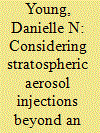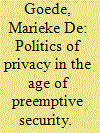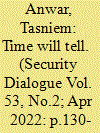| Srl | Item |
| 1 |
ID:
190918


|
|
|
|
|
| Summary/Abstract |
Stratospheric Aerosol Injection (SAI), is often referred to as a ‘Plan B’ if mitigation strategies to reduce emissions fail and the need to rapidly reduce global temperatures becomes urgent. In theory, SAI would help buy more time to bring carbon and other emissions down while also cooling or keeping the planet below the threshold for dangerous warming, though it is not a solution to the problem of climate change in itself. What little attention it has received in International Relations (IR) is usually focused on the need for governance of the technology and assumes that development and use of the technology will be driven primarily by vulnerability to climate impacts. Through an analysis of common security assumptions and preemptive security framings the article shows that while current assessments of SAI focus on the technology’s environmental impact, broader political and security dynamics, particularly the desire to render climate change more intelligible as a security problem with a solution may have substantial influence on how the technology is used and by whom.
|
|
|
|
|
|
|
|
|
|
|
|
|
|
|
|
| 2 |
ID:
130989


|
|
|
|
|
| Publication |
2014.
|
| Summary/Abstract |
In August 2013, a report was leaked to the Washington Post in which it was revealed that the US National Security Agency (NSA) violated its own privacy rules 2,776 times over a one-year period (Gellman 2013). The privacy violations documented in the report range from technical errors to serious violations such as operations without consent from the Foreign Intelligence and Surveillance (FISA) court and breach of the five-year data retention period. Other breaches are described as "broad syntax" errors, which are related to imprecise queries. This type of fault is presumed reducible "if analysts had more complete and consistent information available about … targets."1 Following the recent disclosures concerning the NSA's PRISM program, which has the capacity to search and connect numerous social network databases in the name of security, the importance of the publication of this privacy report cannot be overestimated. While much of the public discussion concerning PRISM has so far focused on the person of Edward Snowden and his unlikely journeys to Hong Kong and Russia, relatively few questions have been raised about the value and legitimacy of the PRISM program itself. The Washington Post revelations concerning the NSA privacy breaches have grabbed the headlines and may lead to Congressional Hearings (Blake 2013). As with other security and surveillance programs, privacy is a key anchor for critical questioning and public debate
|
|
|
|
|
|
|
|
|
|
|
|
|
|
|
|
| 3 |
ID:
185182


|
|
|
|
|
| Summary/Abstract |
Calculating the potential risk of future terrorist violence is at the core of counter-terrorism practices. Particularly in court cases, this potential risk serves as legitimization for the preemptive criminalization of suspicious (financial) behaviour. This article argues that the preemptive temporality seen in such court cases is a practice of ‘sorting time’ and producing distinct legal definitions around future violence. Building on postcolonial and feminist scholarship on temporality, the article examines preemptive temporality as the material, embodied and multiple engagements with time that are enacted in terrorism court cases. Through the use of empirical data obtained from court observations, court judgements and interviews with legal practitioners, accounts of empirical temporalities are traced to illuminate other forms of violence that until now have been overshadowed by the dominant (and relatively unchallenged) perception of future terrorist threats that is enacted in the courtroom. In this way, the article makes two important contributions. First, it advances the theoretical debate on preemptive security through an examination of how legal and security practices co-produce temporality by defining future terrorist violence. Second, it contributes empirically by showing how temporality is constructed in multiple ways, paying specific attention to temporalities resisting dominating perceptions of future terrorist violence.
|
|
|
|
|
|
|
|
|
|
|
|
|
|
|
|